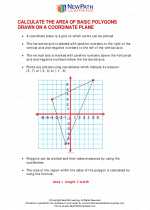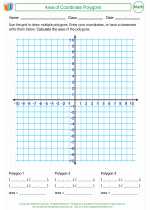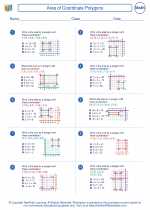Area of Coordinate Polygons -> coordinate polygons
Coordinate Polygons
A polygon is a closed figure made up of line segments. Each vertex of the polygon has a coordinate pair that specifies its location in the coordinate plane. The coordinate plane is formed by two perpendicular number lines, called the x-axis (horizontal) and the y-axis (vertical).
Vertices of a Polygon
The vertices of a polygon are the points at which the line segments meet. Each vertex is represented by a coordinate pair (x, y) that specifies its location in the coordinate plane.
Plotting Polygons
To plot a polygon in the coordinate plane, you simply plot the vertices using their coordinate pairs and then connect the points with line segments. Make sure to follow the order of the vertices when connecting them to ensure the correct shape of the polygon.
Calculating the Area of a Polygon
To calculate the area of a polygon in the coordinate plane, you can use the formula:
Area = 1/2 * |(x1y2 + x2y3 + ... + xn-1yn + xn*y1) - (y1x2 + y2x3 + ... + yn-1xn + yn*x1)|
Where (x1, y1), (x2, y2), ..., (xn, yn) are the coordinates of the vertices of the polygon in order.
Study Guide
- Understand the concept of a polygon and its vertices.
- Learn how to plot the vertices of a polygon in the coordinate plane.
- Practice connecting the plotted points to form the polygon.
- Memorize the formula for calculating the area of a polygon in the coordinate plane.
- Practice solving problems involving the area of polygons in the coordinate plane.
By mastering the concept of coordinate polygons, you'll be able to accurately plot and analyze polygons in the coordinate plane.
[Coordinate Polygons] Related Worksheets and Study Guides:
.◂Math Worksheets and Study Guides Sixth Grade. Area of Coordinate Polygons

 Activity Lesson
Activity Lesson
 Worksheet/Answer key
Worksheet/Answer key
 Worksheet/Answer key
Worksheet/Answer key
 Worksheet/Answer key
Worksheet/Answer key
